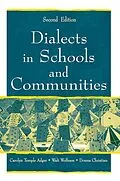This book describes dialect differences in American English and their impact on education and everyday life. It explores some of the major issues that confront educational practitioners and suggests what practitioners can do to recognize students' language abilities, support their language development, and expand their knowledge about dialects. Topics addressed include:
*popular concerns about the nature of language variation;
*characteristic structures of different dialects;
*various interactive patterns characteristic of social groups;
*the school impacts of dialect differences in speaking, writing, and reading, including questions about teaching Standard English; and
*the value of dialect education in schools to enable students to understand dialects as natural and normal language phenomena.
Changesin the Second Edition: In this edition the authors reconsider and expand their discussion of many of the issues addressed in the first edition and in other of their earlier works, taking into account especially the research on dialects and publications for audiences beyond linguistics that have appeared since the first edition. This edition is offered as an updated report on the state of language variation and education in the United States.
Dialects in Schools and Communities is rooted in questions that have arisen in workshops, surveys, classes, discussion groups, and conversations with practitioners and teacher educators. It is thus intended to address important needs in a range of educational and related service fields. As an overview of current empirical research, it synthesizes current understandings and provides key references-in this sense it is a kind of translation and interpretation in which the authors' goal is to bring together the practical concerns of educators and the vantage point of sociolinguistics. No background in linguistics or sociolinguistics is assumed on the part of the reader.
This volume is intended for teacher interns and practicing teachers in elementary and secondary schools; early childhood specialists; specialists in reading and writing; speech/language pathologists; special education teachers; and students in various language specialties.
Autorentext
Adger, Carolyn Temple; Wolfram, Walt; Christian, Donna
Zusammenfassung
Drawing upon more than 30 years of experience in working with statistics, Dr. Richard J. Harris has updated A Primer of Multivariate Statistics to provide a model of balance between how-to and why. This classic text covers multivariate techniques with a taste of latent variable approaches. Throughout the book there is a focus on the importance of describing and testing one's interpretations of the emergent variables that are produced by multivariate analysis. This edition retains its conversational writing style while focusing on classical techniques. The book gives the reader a feel for why one should consider diving into more detailed treatments of computer-modeling and latent-variable techniques, such as non-recursive path analysis, confirmatory factor analysis, and hierarchical linear modeling. Throughout the book there is a focus on the importance of describing and testing one's interpretations of the emergent variables that are produced by multivariate analysis.
Inhalt
Contents: Language Variation in America. Exploring Dialects. Social Interaction. Interpreting Language Difference . Oral Language Instruction. Dialects and Written. Language Variation and Reading. Dialect Awareness for Students. Appendix: A Selective Inventory of Vernacular Structures.
